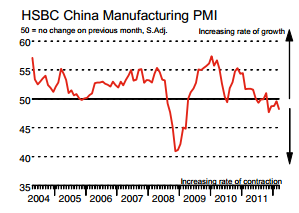Economic Events for May 3, 2012 for the European and US Markets
GBP Nationwide HPI
Change in the selling price of homes with mortgages backed by Nationwide. It’s a leading indicator of the housing industry’s health because rising house prices attract investors and spur industry activity
EUR French Industrial Production
It’s a leading indicator of economic health – production reacts quickly to ups and downs in the business cycle and is correlated with consumer conditions such as employment levels and earnings; measures Change in the total inflation-adjusted value of output produced by manufacturers, mines, and utilities.
GBP Services PMI
Survey of purchasing managers which asks respondents to rate the relative level of business conditions including employment, production, new orders, prices, supplier deliveries, and inventories.
EUR Minimum Bid Rate
Measures Interest rates on the main refinancing operations that provide the bulk of liquidity to the banking system. Short-term interest rates are the paramount factor in currency valuation – traders look at most other indicators merely to predict how rates will change in the future;
EUR ECB Press Conference
It’s the primary method the ECB uses to communicate with investors regarding monetary policy. It covers in detail the factors that affected the most recent interest rate and other policy decisions, such as the overall economic outlook and inflation. Most importantly, it provides clues regarding future monetary policy;
USD Unemployment Claims
Measures the number of individuals who filed for unemployment insurance for the first time during the past week. Although it’s generally viewed as a lagging indicator, the number of unemployed people is an important signal of overall economic health because consumer spending is highly correlated with labor-market conditions.
USD ISM Non-Manufacturing PMI
The Institute for Supply Management measures the level of a diffusion index based on surveyed purchasing managers, excluding the manufacturing industry. It’s a leading indicator of economic health – businesses react quickly to market conditions, and their purchasing managers hold perhaps the most current and relevant insight into the company’s view of the economy.
Euro Dollar
EURUSD (1.314) The euro continues underperforming, down 0.8% as a result of weaker PMI and employment figures, with deterioration in German data driving fears of a slowdown in Europe’s largest economy. Germany’s manufacturing PMI saw a slight decline, to 46.2 vs expectations that it would remain unchanged from 46.3.
Additionally, Germany’s unemployment rate was revised upward to 6.8% as a result of job losses in April, while the aggregate Euro‐Zone employment figures remained unchanged with an unemployment rate of 10.9%. Most importantly, the Eurozone’s composite manufacturing PMI has deteriorated, falling to 45.9 from 46.0, a development that will surely catch the attention of ECB President Mario Draghi given his focus on the index.
The deterioration in the Euro‐Area data will increase the focus on tomorrow’s ECB meeting as market participants focus on policymakers’ outlooks and weigh the probability of a policy response
The Sterling Pound
GBPUSD (1.6185) The pound is weaker, for the third session this week, and is down 0.3%. The decline is likely being driven by domestic factors, including deterioration in the construction PMI and a contraction in money supply data, however EUR weakness may also be a culprit. This week’s key data release for the UK remains is today’s services PMI, which is expected to fall to 54.1. While the BoE and ECB meetings usually overlap at the beginning of each month, the BoE meeting will be taking place next week and will allow for policymakers to make their decision based on fresh PMI data.
Asian –Pacific Currency
USDJPY (80.15) The yen has fallen 0.3% from yesterday’s close amid whispers of BoJ interference, though comments from Moody’s may also be driving weakness. A senior VP at Moody’s has been quoted saying that the BoJ is unlikely to achieve its 1.0% inflation target and may be leading market participants to expect further yen weakness as a result of easing via asset purchases. Trading in Japan remains light given that markets are only open two days this week
Gold
Gold (1651.90) remained under pressure on Thursday after disappointing data from both sides of the Atlantic fueled concerns about global growth, while investors awaited a rate decision by the European Central Bank later in the day for more trading cues.
Spot gold edged down 0.1% to USD 1,650.89 an ounce by 0019 GMT, extending losses from the previous session. US gold also inched down 0.1% to $1,651.90.
Crude Oil
Crude Oil (105.09) prices closed down in New York. The drop follows the higher-than-expected rise in US weekly crude oil stocks. Light Sweet Crude is down 1.06 cents, to 105.09 USD a barrel.




Comments are closed.